The Ivy Bridge Preview: Core i7 3770K Tested
by Anand Lal Shimpi on March 6, 2012 8:16 PM EST- Posted in
- CPUs
- Intel
- Core i7
- Ivy Bridge
Discrete GPU Gaming Performance
Gaming performance with a discrete GPU does improve in line with the rest of what we've seen thus far from Ivy Bridge. It's definitely a step ahead of Sandy Bridge, but not enough to warrant an upgrade in most cases. If you haven't already made the jump to Sandy Bridge however, the upgrade will do you well.
Dragon Age Origins
DAO has been a staple of our CPU gaming benchmarks for some time now. The third/first person RPG is well threaded and is influenced both by CPU and GPU performance. Our benchmark is a FRAPS runthrough of our character through a castle.
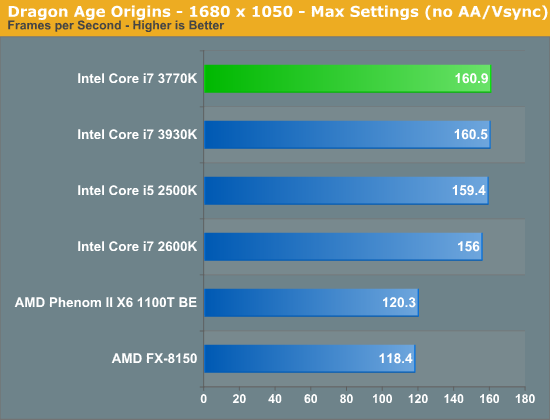
Dawn of War II
Dawn of War II is an RTS title that ships with a built in performance test. I ran at Ultra quality settings at 1680 x 1050:
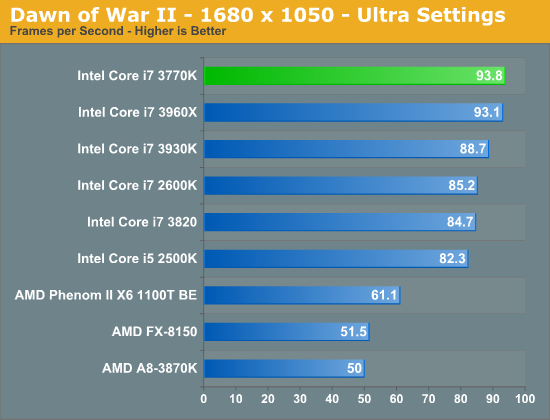
World of Warcraft
Our WoW test is run at High quality settings on a lightly populated server in an area where no other players are present to produce repeatable results. We ran at 1680 x 1050.
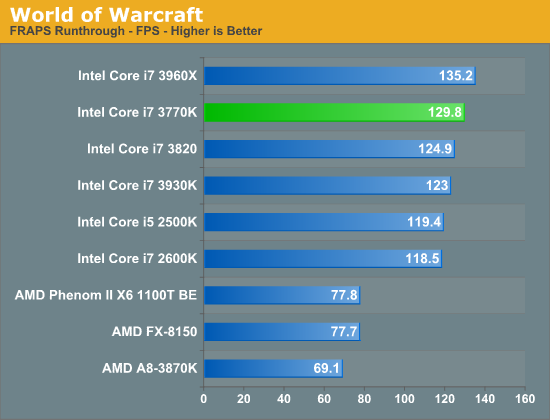
Starcraft 2
We have two Starcraft II benchmarks: a GPU and a CPU test. The GPU test is mostly a navigate-around-the-map test, as scrolling and panning around tends to be the most GPU bound in the game. Our CPU test involves a massive battle of 6 armies in the center of the map, stressing the CPU more than the GPU. At these low quality settings however, both benchmarks are influenced by CPU and GPU. We'll get to the GPU test shortly, but our CPU test results are below. The benchmark runs at 1024 x 768 at Medium Quality settings with all CPU influenced features set to Ultra.
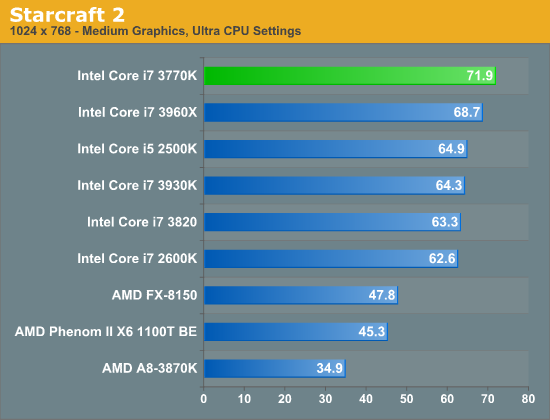
Metro 2033
We're using the Metro 2033 benchmark that ships with the game. We run the benchmark at 1024 x 768 for a more CPU bound test as well as 1920 x 1200 to show what happens in a more GPU bound scenario.

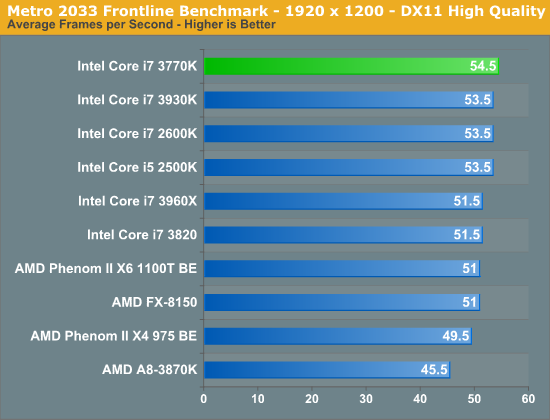
DiRT 3
We ran two DiRT 3 benchmarks to get an idea for CPU bound and GPU bound performance. First the CPU bound settings:
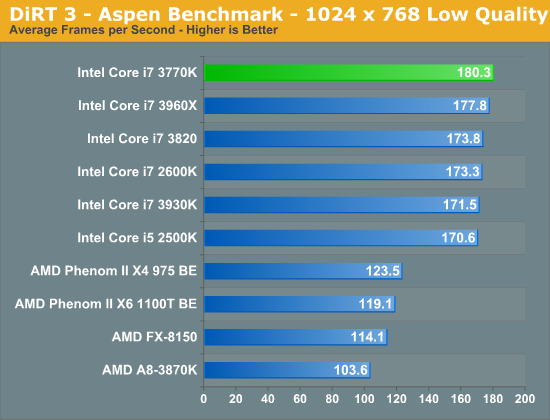
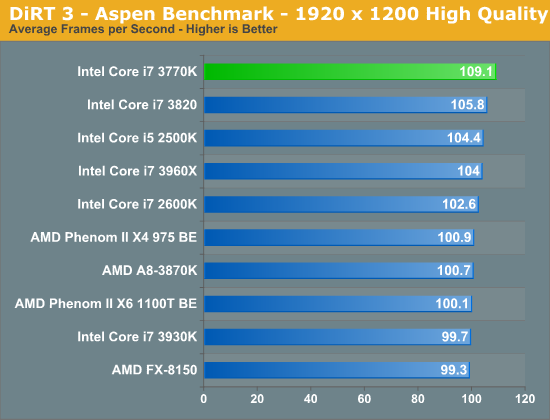
Crysis: Warhead
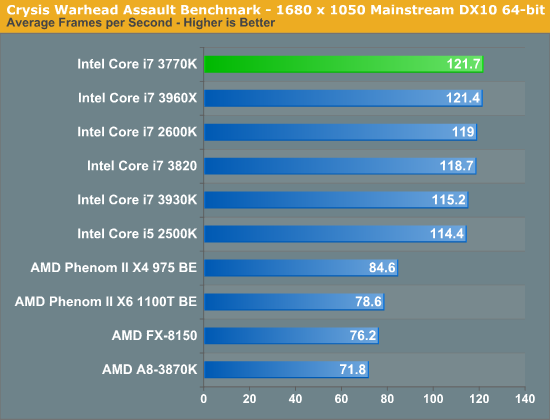
Civilization V
Civ V's lateGameView benchmark presents us with two separate scores: average frame rate for the entire test as well as a no-render score that only looks at CPU performance. We're looking at the no-render score here to isolate CPU performance alone:
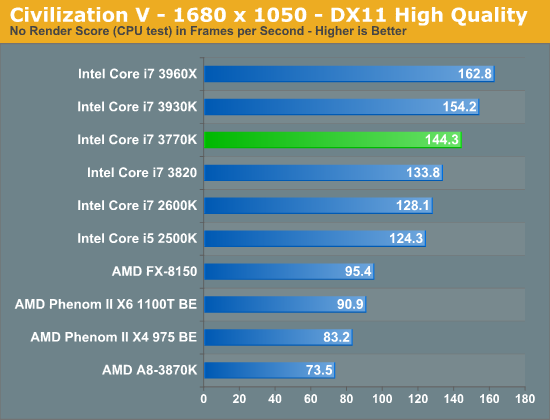










195 Comments
View All Comments
taltamir - Monday, March 12, 2012 - link
Rarson is correct.He isn't suggesting no IGP at all. He is saying put a good IGP on the lower end.
While there ARE people who need a powerful CPU and will not get a video card because they don't play games, those people do not in any way benefit from having a higher end IGP.
High end gamers = discreete GPU + Powerful CPU
Budget gamers = IGP + mid-low range CPU
Non gamers with money = High end CPU + IGP (underused)
Non gamers on a budget = Mid-low range CPU + IGP (underused)
The only people who need a more powerful GPU are the budget gamers and thus it makes sense on the lower end CPUs to have a more powerful IGP.
Urillusion17 - Monday, March 12, 2012 - link
Great article but.... where are the temps??? The few benches I have seen don't mention overclocking, and if they do, they do not mention temps. I am hearing this chip can boil water! I would think that would be as important as anything else...DrWattsOn - Tuesday, March 13, 2012 - link
+1 (very much in agreement)boogerlad - Wednesday, March 14, 2012 - link
is it possible to fully load the igp with an opencl application, and not affect the cpu performance at all? From what I've read, it appears the igp shares the cache with the cpu, so will that affect performance?rocker123 - Monday, March 19, 2012 - link
Generational performance improvements on the CPU side generally fall in the 20 - 40% range. As you've just seen, Ivy Bridge offers a 7 - 15% increase in CPU performance over Sandy Bridge - making it a bonafide tick from a CPU perspectiveShould be :Generational performance improvements on the GPU side generally fall in the 20 - 40% range
rocker123 - Monday, March 19, 2012 - link
Generational performance improvements on the CPU side generally fall in the 20 - 40% range. As you've just seen, Ivy Bridge offers a 7 - 15% increase in CPU performance over Sandy Bridge - making it a bonafide tick from a CPU perspectiveShould be :Generational performance improvements on the GPU side generally fall in the 20 - 40% range
tipoo - Monday, March 19, 2012 - link
They give the drivers their own tweaks and bug fixes, but I doubt they could do something like add T&L without the manufacturers support. In fact, they didn't, unless they have bigger driver teams now.ClagMaster - Wednesday, March 21, 2012 - link
"Personally, I want more and I suspect that Haswell will deliver much of that. It is worth pointing out that Intel is progressing at a faster rate than the discrete GPU industry at this point. Admittedly the gap is downright huge, but from what I've heard even the significant gains we're seeing here with Ivy will pale in comparison to what Haswell provides."Personally, I believe on-board graphics will never be on par with a dedicated graphics part. And it is obcessive-compulsive ridiculous to compare the performance of the HD4000 with discrete graphics and complain its not as good.
The HD4000 is meant for providing graphics for business and multi-media computers. And for that purpose it is outstanding.
If you want gaming or engineering workstation performance, get a discrete graphics card. And stop angsting about how bad onboard graphics is to discrete graphics.
pottermd - Thursday, March 22, 2012 - link
Today's desktop processors are more than fast enough to do professional level 3D rendering at home.The article contained this statement. It's not really true. I've had a long nap and the render I'm doing is still running. :)
Dracusis - Friday, April 6, 2012 - link
"The people who need integrated graphics"No one *needs* integrated graphics. But not everyone needs discrete graphics. The higher performance an IGP has, the less people overall will *need* DGPs.
Not all games need dedicated graphics cards, just the multi million dollar re-hashed COD's that choke retail stores. There are literally thousands of other games around that only require a small amount of graphics processing power. Flash now has 3D accelerated content and almost every developer using it will target IGP performance levels. Almost all casual game developers target IGPs as well, they're not selling to COD players. Sure, most of those games won't need a hight end CPU as well, but people don't buy computers to play casual games, they buy them for a massive range of tasks, the vast majority of which will be CPU bound so faster would be better.
Also, as an indie game developer I hit performance walls with CPUs more often than I do with GPUs. You can always scale back geometry/triangle counts, trim or cut certain visual effects but cutting back on CPU related overheads generally means you're cutting out gameplay.